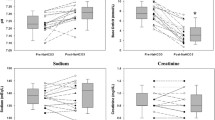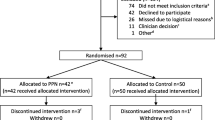Summary
The elimination kinetics of thiopentone was studied in 7 newborns delivered by Caesarean section and in their mothers who had received the drug for induction of anaesthesia. At delivery, 4–9 min after induction, drug concentrations in cord blood were half those in material blood. The mean half-life of thiopentone in the newborns was about double that in their mothers (15 vs 7 h) confirming a disposition similar to other barbiturates. For the first time renal clearance of thiopentone was estimated in the newborn; 0.074 ml/h/kg. Only 0.0007% (about 2 µg) of the maternal dose was recovered in the urine of newborns over 36 h. Pentobarbitone, an active metabolite, was not detected in any specimen. The findings demonstrate the reliability of current anaesthesiological technique (thiopentone-succinylcholine-oxygen) with minimal fetal exposure to the drug.
Similar content being viewed by others
References
Moore J, Dundee JW (1983) Analgesia in labour. In: Lewis P (ed) Clinical pharmacology in obstetrics. Wright, Bristol, pp 337–359
Saidman LJ (1974) Uptake, distribution and elimination of barbiturates. In: Eger EI II (ed) Anesthetic uptake and action. Williams and Wilkins, Baltimore, pp 264–284
Ghoneim MM, Van Hamme MJ (1978) Pharmacokinetics of thiopentone: effects of enflurane and nitrous oxide anaesthesia and surgery. Br J Anaesth 50: 1237–1242
Saidman LJ, Eger EI (1966) The effect of thiopental metabolism on duration of anesthesia. Anesthesiology 27: 118–126
Duvaldestin P (1981) Pharmacokinetics in intravenous anesthetic practice. Clin Pharmacokinet 6: 61–82
Ghoneim MM, Korttila K (1977) Pharmacokinetics of intravenous anaesthetics: implications for clinical use. Clin Pharmacokinet 2: 344–372 (1977)
McKechnie FB, Converse JC (1955) Placental transmission of thiopental. Am J Obstet Gynecol 70: 639–644
Finster M, Mark LC, Morishima HO, Moya F, Perel JM, James LS, Dayton PG (1966) Plasma thiopental concentrations in the newborn following delivery under thiopental-nitrous oxide anesthesia. Am J Obstet Gynecol 95: 621–629
Morgan DJ, Blackman GL, Paull JD, Wolf LJ (1981) Pharmacokinetics and plasma binding of thiopental. II. Studies at cesarean section. Anesthesiology 54: 474–480
Morgan DJ, Beamiss CG, Blackman GL, Paull JD (1982) Urinary excretion of placentally transferred thiopentone by the human neonate. Dev Pharmacol Ther 5: 136–142
Morgan DJ, Paull JD, Tho CT, Blackman GL (1984) Aortocaval compression and plasma concentrations of thiopentone at Caesarean section. Br J Anaesth 56: 349–354
Finster M, Morishima HO, Mark LC, Perel JM, Dayton PG, James LS (1972) Tissue thiopental concentrations in the fetus and newborn, Anesthesiology 36: 155–158
Brodie BB, Mark LC, Papper EM, Lief PA, Bernstein E, Rovenstein EA (1950) The fate of thiopental in man and a method for its estimation in biological material. J Pharmacol Exp Ther 98: 85–96
Hodgkinson R, Marks GF, Kim SS, Miclat NM (1977) Neonatal neurobehavioral tests following vaginal delivery under ketamine, thiopental, and extradural anesthesia. Anaesth Analg 56: 548–553
Neims AH, Warner M, Loughnan PM, Aranda JV (1976) Developmental aspects of the hepatic cytochrome P450 monooxygenase system. Ann Rev Pharmacol Toxicol 16: 427–445
Morselli PL, Franco-Morselli R, Bossi L (1983) Clinical pharmacokinetics in newborns and infants. Age-related differences and therapeutic implications. In: Gibaldi M, Prescott L (eds) Handbook of clinical pharmacokinetics. ADIS Health Science Press, New York, pp 98–141
Boréus LO (1982) Principles of pediatric pharmacology. Churchill Livingstone, New York
Krauer B, Draffan GH, Williams FM, Clare RA, Dollery CT, Hawkins DF (1973) Elimination kinetics of amobarbital in mothers and their newborn infants. Clin Pharmacol Ther 14: 442–447
Kosaka Y, Takahashi T, Mark LC (1969) Intravenous thiobarbiturate anesthesia for cesarean section. Anesthesiology 31: 489–506
Mayumi T, Matsumiya N, Namiki A (1980) National survey on the type of anesthesia for cesarean section in Japan. J Clin Anesth 4: 1465–1468
Mark LC (1980) The dilemma of general anesthesia for cesarean section: Adequate fetal oxygenation vs. maternal awareness during operation. Anesthesiology 56: 405–406
Stanski DR (1981) Pharmacokinetic modelling of thiopental. Anesthesiology 54: 446–448
Gill R, Lopes AAT, Moffat AC (1981) Analysis of barbiturates in blood by high-performance liquid chromatography. J Chromatogr 226: 117–123
Shiu GK, Nemoto EM (1982) Simple, rapid and sensitive reversed-phase high-performance liquid chromatographic method for thiopental and pentobarbital determination in plasma and brain tissue. J Chromatogr 227: 207–212
Carrol FI, Smith D, Mark LC, Brand L, Perel JM (1977) Determination of optically active thiopental, thiamylal, and their metabolites in human urine. Drug Metab Dispos 5: 343–354
Schepens P, Heyndrickx A (1975) Placental transfer of thiopental. Eur J Toxicol 8: 87–93
Nishimura H (1973) Comparative study on maternal-embryonic transfer of drugs in man and laboratory animals. In: Boréus LO (ed) Fetal pharmacology. Raven Press, New York, pp 47–53
Morgan DJ, Blackman GL, Paull JD, Wolf LJ (1981) Pharmacokinetics and plasma binding of thiopental. I: Studies in surgical patients. Anesthesiology 54: 468–473
Martin BK (1967) Drug urinary excretion data: Some aspects concerning the interpretation. Br J Pharmacol Chemother 29: 181–193
Gibaldi M, Perrier D (1982) Pharmacokinetics, 2nd edn. Marcel Dekker, New York
Author information
Authors and Affiliations
Rights and permissions
About this article
Cite this article
Gaspari, F., Marraro, G., Penna, G.F. et al. Elimination kinetics of thiopentone in mothers and their newborn infants. Eur J Clin Pharmacol 28, 321–325 (1985). https://doi.org/10.1007/BF00543331
Received:
Accepted:
Issue Date:
DOI: https://doi.org/10.1007/BF00543331




